Related Research Articles

Chios is the fifth largest of the Greek islands, situated in the northern Aegean Sea. The island is separated from Turkey by the Chios Strait. Chios is notable for its exports of mastic gum and its nickname is "the Mastic Island". Tourist attractions include its medieval villages and the 11th-century monastery of Nea Moni, a UNESCO World Heritage Site.

The Charleston is a dance named after the harbor city of Charleston, South Carolina. The rhythm was popularized in mainstream dance music in the United States by a 1923 tune called "The Charleston" by composer/pianist James P. Johnson which originated in the Broadway show Runnin' Wild and became one of the most popular hits of the decade. Runnin' Wild ran from 29 October 1923 through 28 June 1924. The peak year for the Charleston as a dance by the public was mid-1926 to 1927.
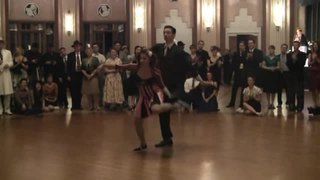
Swing dance is a group of dances that developed with the swing style of jazz music in the 1920s–1940s, with the origins of each dance predating the popular "swing era". During the swing era, there were hundreds of styles of swing dancing, but those that have survived beyond that era include: Lindy Hop, Balboa, Collegiate Shag, and Charleston. Today, the best-known of these dances is the Lindy Hop, which originated in Harlem in the early 1930s. While the majority of swing dances began in African American communities as vernacular African American dances, some influenced swing-era dances, like Balboa, developed outside of these communities.
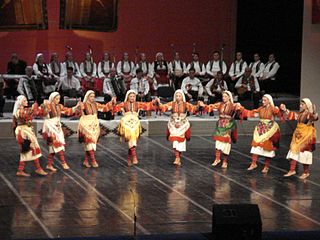
Hora, also known as horo and oro, is a type of circle dance originating in the Balkans but also found in other countries.

Circle dance, or chain dance, is a style of dance done in a circle or semicircle to musical accompaniment, such as rhythm instruments and singing. Circle dancing is probably the oldest known dance formation and was part of community life from when people first started to dance. Unlike line dancing, circle dancers are in physical contact with each other; the connection is made by hand-to-hand, finger-to-finger or hands-on-shoulders. It is a type of dance where anyone can join in without the need of partners. Generally, the participants follow a leader around the dance floor while holding the hand of the dancers beside them. The dance can be gentle or energetic.

The music of Palestine is one of many regional subgenres of Arabic music. While it shares much in common with Arabic music, both structurally and instrumentally, there are musical forms and subject matter that are distinctively Palestinian.

In the Groove is a rhythm game published by RedOctane and developed by Roxor Games, and is the first game in the In the Groove series. The game was shown in an official beta-testing preview on July 9, 2004, and was officially released in arcades around August 30, 2004.
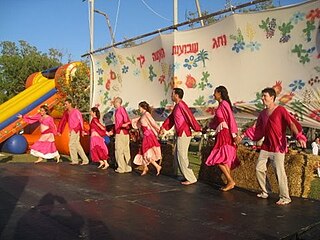
Israeli folk dancing is a form of dance usually performed to songs in Hebrew, or to other songs which have been popular in Israel, with dances choreographed for specific songs. Israeli dances include circle, partner and line dances. As almost all dances are intentionally choreographed, and the choreographers are known and attributed, the reference to these dances as "folk dances" is sometimes controversial among the general folk dance community. The recent trend of dances becoming much more complex and "professional" has led some to use the alternative term "Recreational Israeli Dancing".
A drop or beat drop in popular music, especially electronic dance music styles, is a point in a music track where a sudden change of rhythm or bass line occurs, which typically is preceded by a build section and break.

The Chios massacre was the killing of tens of thousands of Greeks on the island of Chios by Ottoman troops during the Greek War of Independence in 1822. Greeks from neighbouring islands had arrived on Chios and encouraged the Chians to join their revolt. In response, Ottoman troops landed on the island and killed thousands. The massacre of Christians provoked international outrage and led to increasing support for the Greek cause worldwide.

The Ballos Sirtos is a Greek folk island dance from Greece. There are also different versions in other Balkan countries.
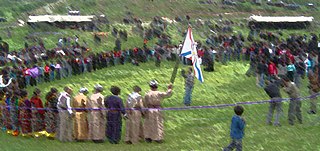
Assyrian folk dances are sets of dances that are performed throughout the world by Assyrians, mostly on occasions such as weddings, community parties and other jubilant events.
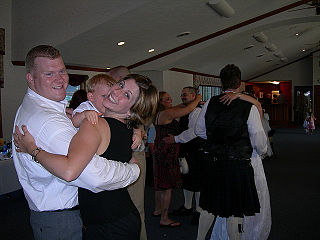
A slow dance is a type of partner dance in which a couple dance slowly, swaying to the music. This is usually done to very slow-beat songs, namely sentimental ballads.

Greek dances (horos) is a very old tradition, being referred to by authors such as Plato, Aristotle, Plutarch and Lucian. There are different styles and interpretations from all of the islands and surrounding mainland areas. Each region formed its own choreography and style to fit in with their own ways. For example, island dances have more of a different smooth flow to them, while Pontic dancing closer to Black Sea, is very sharp. There are over 10 000 traditional dances that come from all regions of Greece. There are also pan-Hellenic dances, which have been adopted throughout the Greek world. These include the syrtos, kalamatianos, pyrrhichios, hasapiko and sirtaki.

Syrtos is, in classical and modern Greece: a folk dance in which the dancers link hands to form a chain or circle, headed by a leader who intermittently breaks away to perform improvised steps.

Nisiotika are the songs and dances of Greek islands with a variety of styles, played by ethnic Greeks in Greece, Cyprus, Australia, the United States and elsewhere.
Italian Folk Dance has been an integral part of Italian culture for centuries. Dance has been a continuous thread in Italian life from Dante through the Renaissance, the advent of the Tarantella, and the modern revivals of folk music and dance.

Mastic is a resin obtained from the mastic tree. It is also known as tears of Chios, being traditionally produced on the island Chios, and, like other natural resins, is produced in "tears" or droplets.
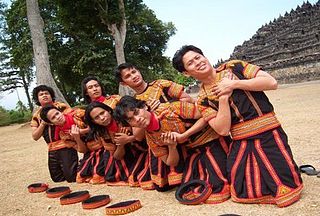
Saman is one of the most popular dances in Indonesia. Its origin is from the Gayo ethnic group from Gayo Lues, Aceh province, Indonesia, and is normally performed to celebrate important occasions. The dance is characterized by its fast-paced rhythm and common harmony between dancers. These two elements are key figures of Saman, and are among the reasons Saman are widely known and practiced in Indonesia, besides being relatively easy to learn.
References
- ↑ Γιαννης ΠΡΑΝΤΣΙΔΗΣ Ο χορός στην ελληνική παράδοση κaι η διδaσκαλια του Yiannis PRANTZIDIS Dance in Greek Tradition and the Teaching of it EKDOTIKI AIGINION pp 356
- ↑ "Levendiax Pirgousikos" . Retrieved 26 December 2016.